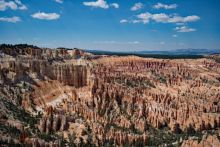Geoscience Currents transmit snapshots of the many facets of the geoscience profession, in-depth case studies of how geoscience is applied, factsheets that provide rigorous introductions to a range of geoscience topics, workforce trends, and career paths.
Partner with us to help support well-informed public policy and decision making with expert, impartial geoscience information. Visit our Sponsorships page for more information or email sponsorships@americangeosciences.org.
Displaying 211 - 220 of a total of 225 items

September 26, 2008
The states with the lowest percentage of under-represented minorities have relatively small populations with more than 50% of the people living in rural areas. The under-represented population includes Black and African American, American Indian and Alaska Natives, Native Hawaiian and other Pacific...

September 15, 2008
Total federal funding for geoscience research has leveled off since 2003, as have the proportions of funding for atmospheric science, geological science, and oceanography. Since the mid-1980’s however, the percentage of geoscience research funding applied to interdisciplinary geosciences has...

July 22, 2008
The states with the most geoscience departments are in California, New York, and Pennsylvania. Students in states that have a larger number of universities with geoscience departments will, in general, have a greater diversity of options to major in the field in their region.

July 09, 2008
Tenure-track geoscience faculty progress steadily through the academic ranks from assistant professor to full professor by the age of 60. Full professors tend to work later into their career, and there is a cross-over in the population of full professors and emeritus in the 71-75 age range.
The...

June 27, 2008
Individuals who hold terminal geoscience master’s or doctoral degrees have similar academic backgrounds. Both groups have comparable percentages of bachelor degrees in business (~ 1%), engineering (12-17%), geosciences (50-56%), other science & mathematics (18-19%), and other degree fields (12-...

June 17, 2008
College graduate workers with their highest degree in the geosciences comprise 23% of the mining industry, 11% of the petroleum industry, and 3% of the basic research industry. If a worker has multiple degrees, only their highest degree (bachelor’s, master’s, doctorate, or professional) is...

June 03, 2008
Females make up 14.2% of tenure-track faculty in geosciences departments compared to 28% in tenure-track positions in all science and engineering fields. In the geosciences, 18.6% of non-tenure track positions are held by women. The level of female participation in faculty positions has not changed...

May 02, 2008
As for January 2008, there were 12,354 geoscience faculty employed in geoscience departments at US colleges and universities, compared to 13,554 in 1999. The numbers of Emeritus and Assistant Professors remained the same over this time, but the number of all other faculty dropped. Currently, 56% of...

April 10, 2008
The steep increase in the price of crude oil in the United States remains a headline issue, along with the falling US dollar. The drop in the dollar has caused concern in oil-producing countries which use it as the economic basis for the commodity, and often their currency. The chart below shows...

March 26, 2008
The number of students enrolled in the geosciences in US colleges and universities remained relatively steady in 2007 based on preliminary numbers, with 19,216 undergraduates and 7,944 graduate students enrolled.
Pages
Upcoming Webinars

